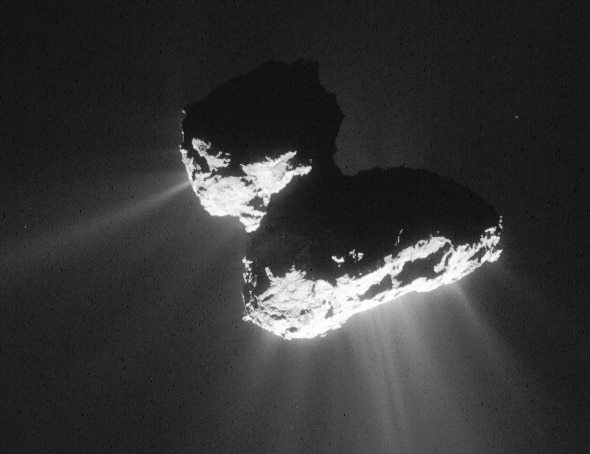Create a free profile to get unlimited access to exclusive videos, sweepstakes, and more!
How to Make a Rubber Ducky Comet: Smash Two Comets Together! Carefully.

Why is the comet 67P Churyumov-Gerasimenko shaped like a rubber ducky?*
It was a bit of a surprise when the Rosetta probe, after a decade of travel around the Sun, approached the comet and sent the first decently resolved pictures of it back to Earth. We knew going in that most asteroids and comets just a few kilometers across are oddly shaped; they lack the gravity needed to make themselves spheres, and after 4 billion years of impacts their shape can be decidedly odd.
We even know of a few bowling pin shaped comets, like Hartley 2 and Wild 2. But 67P just reinforced the weirdness of this all with its two lobes mismatched in size and shape.
So, why? What’s going on? Comets are rock, gravel, and dust all mixed together with various ices holding them together, frozen stuff like water, carbon dioxide, and carbon monoxide. Did these weird, dumbbell-shaped comets start off more round and, for some reason, lost more ice in their midsections, leaving behind the two big lobes? Or were they the result of two interplanetary snowballs that collided and stuck together?
New results from the Rosetta team have finally answered this question. 67P used to be two different comets, but they merged to become the bizarre bit of solar system fluff we now know and love.
How? Well, when two comets love each other very much …
Oh wait, no, that’s not it. Well, actually, kinda. Back in May 2015 astronomers came up with a pretty good scenario on how to form a rubber ducky comet. Two smaller comets collide in a slow-speed, grazing impact. Some material is lost, and the two major pieces separate a bit, but the impact was slow enough that they become gravitationally bound. They fall back together, stick, and voilà!
As for the “how do we know?,” that’s more subtle, and quite clever. Rosetta has been orbiting 67P since August of 2014. Over that time it’s taken a vast number of high-resolution images, revealing details of the surface. Both lobes have flat regions all over them arranged like terraces, and the steps in between the terraces show layering; these probably built up layer by layer over time when the comet(s) first formed billions of years ago.
If the comet formed as a single object that has since eroded, you’d expect the terraces and layers on both lobes to align so that their flat sides were perpendicular to the center of the comet, somewhere in the neck, plated around it (something like the individual panels on a soccer ball, which all are perpendicular to the ball’s center, or, of you prefer, more-or-less parallel to the ball’s surface).
If, instead, the two lobes formed individually and later merged, then the terraces on each lobe would be perpendicular to the center of their respective lobe.
Using 3-D modeling, the scientists mapped the orientation of the terraces. And what they found is the latter: The terraces align to each lobe individually, not to the center of the comet as a whole. This strongly indicates the lobes formed separately, later merging.
That is very, very cool. I’ve been curious about this ever since we literally got the first good pictures of the comet. I allowed myself a bit of speculation back then and felt that a low-speed collision between two small comets was unlikely. I guess I was wrong! While space is big, I neglected to consider that time is also long, and over an eon or four collisions may be likely. After all, 67P isn’t the only object like this; we know of quite a few binary and dogbone-shaped asteroids, too.
How about that? The beauty of this, too, is that the answer gives us insight into more than just why the comet is funny-looking. It also tells us about how comets behave, what their formation processes are like, what happens after they form, and, perhaps most interestingly, how often objects in space collide. That in turn helps us understand the history of our solar system in general, as well as how often the Earth itself gets hit by such cosmic debris.
Over time, we do get hit. The rate of such impacts is a good thing to know, so that we can better understand how to prevent them.
After all, we don’t just want to be a … sitting duck.
*Hint: It’s not because it makes bath time so much fun.














